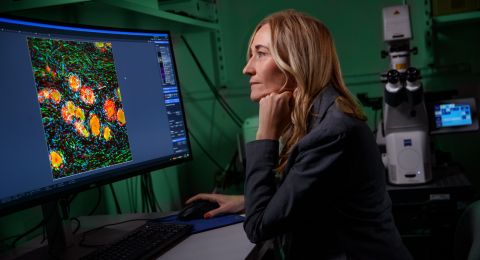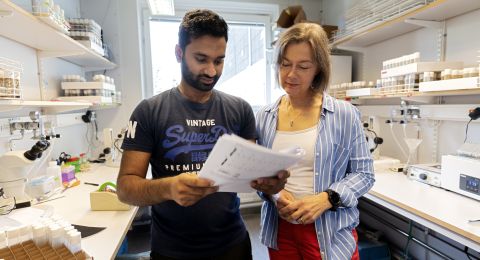
Project Grants 2012
Comprehensive analysis of the kidney glomerulus and its diseases
Principal investigator:
Karl Tryggvason, Professor of Medical Chemistry
Co-investigator:
Christer Betsholtz
Institution:
Karolinska Institutet
Grant in SEK:
SEK 16.7 million over three years
In 2003, researchers announced that they had mapped the entire human genome. The gigantic project took 13 years and involved hundreds of researchers. Since then, technology has undergone a virtually explosive development. Today, it only takes a few days to read an individual person's genetic material and soon the cost is estimated to be down to a few thousand Swedish kronor per person.
This development opens opportunities that researchers could previously only dream of. For Karl Tryggvason, it means that he can finally conduct what he calls the ”ultimate experiment” for his research. In the coming year, he will freely search in the genes of patients with diabetes and try to understand why some have severe damage to both kidneys and eyes, while others avoid such damage entirely.
“Around one third of all diabetics have these complications. When a diabetes patient starts to develop kidney disease, it is nearly like a death sentence. The five-year prognosis for a person who ends up on dialysis is just as poor for women who suffer from ovarian cancer,” says Karl Tryggvason, Professor of Medical Chemistry at Karolinska Institutet.
A unique group of siblings will have their entire genome mapped
Nobody knows in advance who will be afflicted. However, if it is possible to find genetic causes behind the damage, a great deal is gained. Using new diagnostics tests, one could find those that are in the risk zone.
“Then more intensive focus can be placed on those people and help them keep their blood sugar at normal levels,” says Karl Tryggvason.

To find the genes behind the kidney damage, Karl Tryggvason gathered a unique group of diabetic patients in the 1990s. They are 70 sibling pairs who have both had juvenile diabetes, type-1 diabetes. One of the siblings developed kidney disease and received dialysis, received a transplant or died from the damage. The other sibling has lived with diabetes for more than 25 years and still has normally functioning kidneys.
“They may have had as poor blood-sugar values and they may often have been thirsty and tired, but they do not suffer from the horrible diabetes complications,” says Karl Tryggvason.
Now or never
It is the genes of these sibling pairs, 140 individuals in total, which he is now having analyzed. The samples will be sent off to two different companies specialized on mapping entire genomes, one in California and one in China. The two companies use slightly different methods. To be certain that they get the same results, some individuals' genes will be mapped by both companies. Karl Tryggvason believes that the entire mapping should be finished towards the end of 2013 and he then hopes to finally be able to find the genes that he has long searched for.
“If we do not find these mutations now, we will never find them,” he says.
Sugar sticks to proteins in the fine filters of the kidneys
In the project, which recently received renewed financing from the Knut and Alice Wallenberg Foundation, and which is being conducted in collaboration with Christer Betsholtz, Professor of Vascular Biology, the researchers are also mapping the gene activity in damaged and healthy kidneys.
“We have found 300 genes that are nearly solely active in the kidneys' filtering system,” says Karl Tryggvason.
When the kidneys are damaged, it is mainly a part that is called a glomerulus that is destroyed. Glomeruli are clusters of fine blood vessels, capillaries, which filter the blood. The capillaries are supported by the so-called basement membrane. When a person often has high blood sugar, sugar molecules spontaneously stick to this basement membrane. It becomes lightly glazed and this appears to lead to certain persons being unable to renew their membrane.

“Normally, one has a certain turnover of the basement membrane, but these individuals cannot handle this turnover,” says Karl Tryggvason.
Instead, the sugar-damaged tissue accumulates and the basement membrane increases in thickness. It can become up to ten times thicker than normal and the kidneys then lose their function. To better understand how mutations affect these mechanisms, Karl Tryggvason collaborates with Christer Betsholtz.
If sugar can be prevented from attaching to the connective tissue, it is probably also possible to stop the damage.
“We are also involved in a company that is developing a medicine that prevents sugar molecules from binding to the basement membrane,” says Karl Tryggvason.
The medicine will hopefully prevent both kidney damage and eye damage in diabetes patients. These two kinds of complications most often go hand in hand and are probably caused by the same mechanisms.
Although Karl Tryggvason's research is primarily conducted on persons with type-1 diabetes, those with type-2 diabetes will also benefit from the results. According to WHO figures, nearly 350 million people suffer from diabetes in the world and the problems are growing like wildfire on the tail of obesity. So if Karl Tryggvason succeeds in his intentions, it may affect the lives of many people.
Text Ann Fernholm
Translation Semantix
Photo Magnus Bergström



